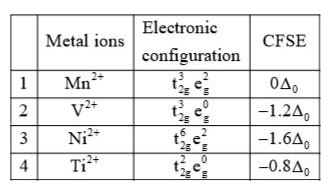The hexaaqua complex[Ni(H2O)6]2+ is green, whereas the corresponding ammonia complex [Ni(NH3)6]2+ is violet. Explain.
To explain why the hexaaqua complex (Ni(H2O)6)2+ is green while the ammonia complex (Ni(NH3)6)2+ is violet, we can analyze the electronic transitions and the colors associated with these complexes.
1. Identify the oxidation state of Nickel in the complexes:
- In both complexes, Nickel is in the +2 oxidation state. This can be determined from the overall charge of the complexes and the neutral nature of the ligands (water and ammonia).
2. Determine the electronic configuration of Nickel:
- Nickel (Ni) has an atomic number of 28. The electronic configuration is (Ar)3d84s2. In the +2 oxidation state, it loses two electrons from the 4s orbital, resulting in a configuration of 3d8.
3. Understand the nature of the ligands:
- Water (H2O) is a weak field ligand, while ammonia (NH3) is a stronger field ligand. This difference in ligand strength affects the splitting of the d-orbitals in the presence of the ligands.
4. Analyze the crystal field splitting:
- In the presence of the weak field ligand H2O, the d-orbitals split into two energy levels, with a smaller energy gap (Δ). For the complex (Ni(H2O)6)2+, the energy gap is small, allowing for the absorption of lower energy light (red light).
5. Determine the color of the hexaaqua complex:
- Since red light is absorbed, the complementary color observed is green. Therefore, (Ni(H2O)6)2+ appears green.
6. Analyze the ammonia complex:
- For the ammonia complex (Ni(NH3)6)2+, the stronger field ligand NH3 causes a larger splitting of the d-orbitals, resulting in a larger energy gap (Δ). This allows for the absorption of higher energy light (yellow light).
7. Determine the color of the ammonia complex:
- Since yellow light is absorbed in this case, the complementary color observed is violet. Thus, (Ni(NH3)6)2+ appears violet.
Conclusion:
The differences in color between the two complexes arise from the nature of the ligands and the resulting crystal field splitting of the d-orbitals, which determines the wavelengths of light absorbed and the complementary colors observed.
- In both complexes, Nickel is in the +2 oxidation state. This can be determined from the overall charge of the complexes and the neutral nature of the ligands (water and ammonia).
- Nickel (Ni) has an atomic number of 28. The electronic configuration is (Ar)3d84s2. In the +2 oxidation state, it loses two electrons from the 4s orbital, resulting in a configuration of 3d8.
- Water (H2O) is a weak field ligand, while ammonia (NH3) is a stronger field ligand. This difference in ligand strength affects the splitting of the d-orbitals in the presence of the ligands.
- In the presence of the weak field ligand H2O, the d-orbitals split into two energy levels, with a smaller energy gap (Δ). For the complex (Ni(H2O)6)2+, the energy gap is small, allowing for the absorption of lower energy light (red light).
- Since red light is absorbed, the complementary color observed is green. Therefore, (Ni(H2O)6)2+ appears green.
- For the ammonia complex (Ni(NH3)6)2+, the stronger field ligand NH3 causes a larger splitting of the d-orbitals, resulting in a larger energy gap (Δ). This allows for the absorption of higher energy light (yellow light).
- Since yellow light is absorbed in this case, the complementary color observed is violet. Thus, (Ni(NH3)6)2+ appears violet.
The differences in color between the two complexes arise from the nature of the ligands and the resulting crystal field splitting of the d-orbitals, which determines the wavelengths of light absorbed and the complementary colors observed.
Similar Questions
Knowledge Check
The complex ion [Ni(CN)4]2− is :
ASquare planar and diamagneticBTetrahedral and paramagneticCSquare planar and paramagneticDTetrahedral and diamagnetic
A solution of [Ni(H2O)6]2+ is green but a solution of [Ni(CN)4]2− is colourless Explain.
View SolutionExplain [Co(NH3)6]3+ is an inner orbital complex whereas [Ni(NH3)6]2+ is an outer orbital complex.
View SolutionIn [Ni(H2O)6]2+ , the hybridisation of central metal ion is :
View SolutionThe hybridization involved in complex [Ni(CN)4]2− is (At.No.Ni=28)
View SolutionSelect incorrect match for [M(H2O)6]2+ complex.

View SolutionAssertion A solution of [Ni(H2O)6]2+ is green but a solution of [Ni(CN)4]2+ is colourless
Reason [Ni(CN)4]2+ is square planar complex .
View SolutionNiCl2+NH3(excess)→[Ni(NH3)6]2+
View Solution
